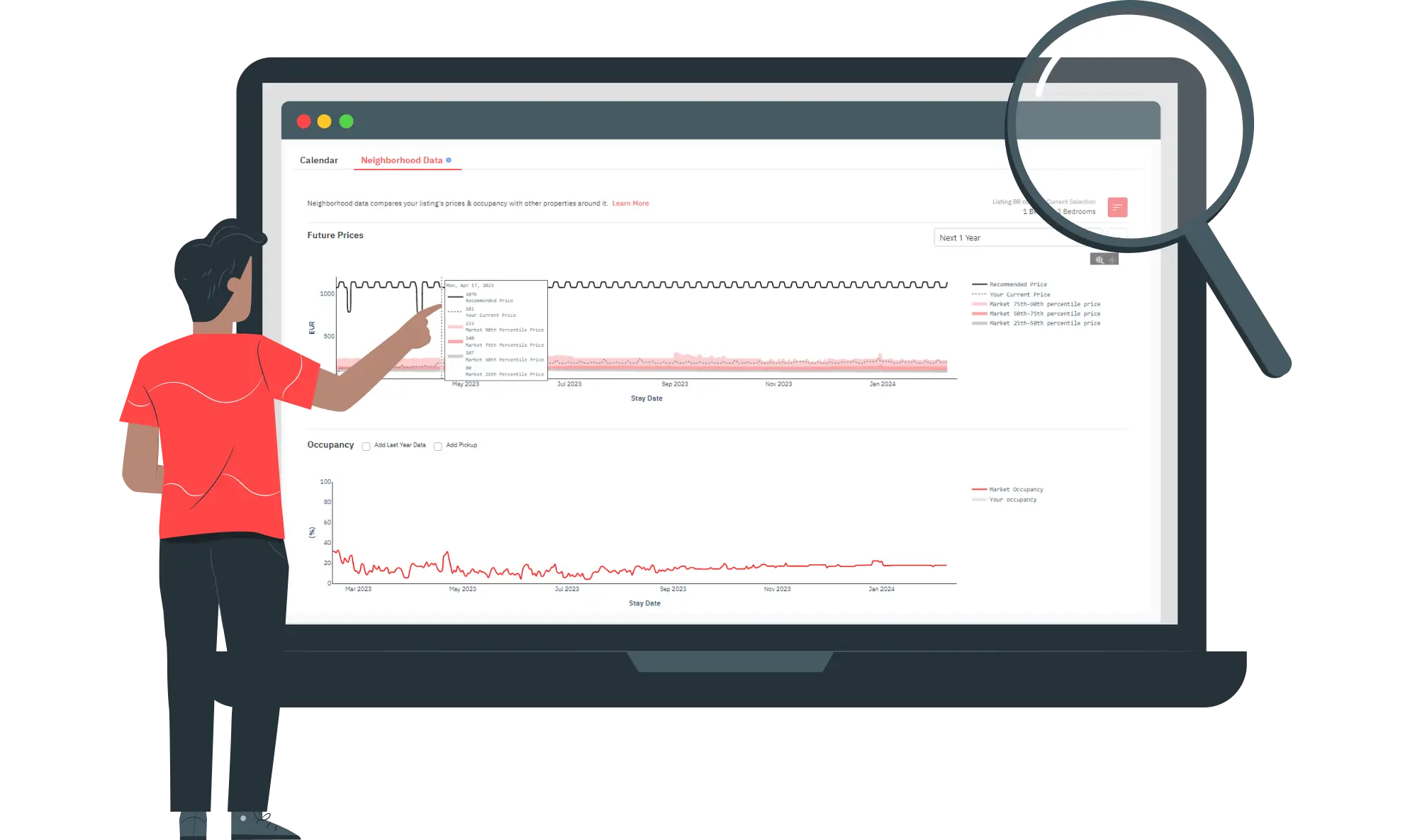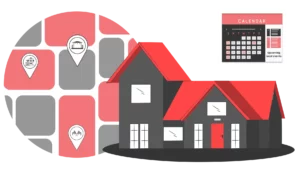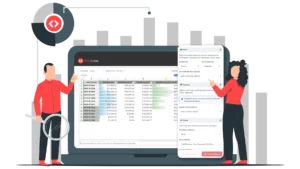Updated: October 12, 2024
With PriceLabs and Airbnb tools, unlock the secrets to effortlessly identifying Airbnb competition. Nail pricing, amenities, and listing allure to stay ahead and attract more guests!
In the competitive landscape of Airbnb hosting, identifying Airbnb competition is significant for maximizing bookings and revenue. With over 4 million hosts worldwide and a staggering 900 million guest arrivals across more than 220 countries and 100,000 cities, standing out is more important than ever. In 2023 alone, Airbnb hosts collectively earned over USD 57 billion, with bookings for nights and experiences reaching 448 million—a 14 percent increase from the previous year.
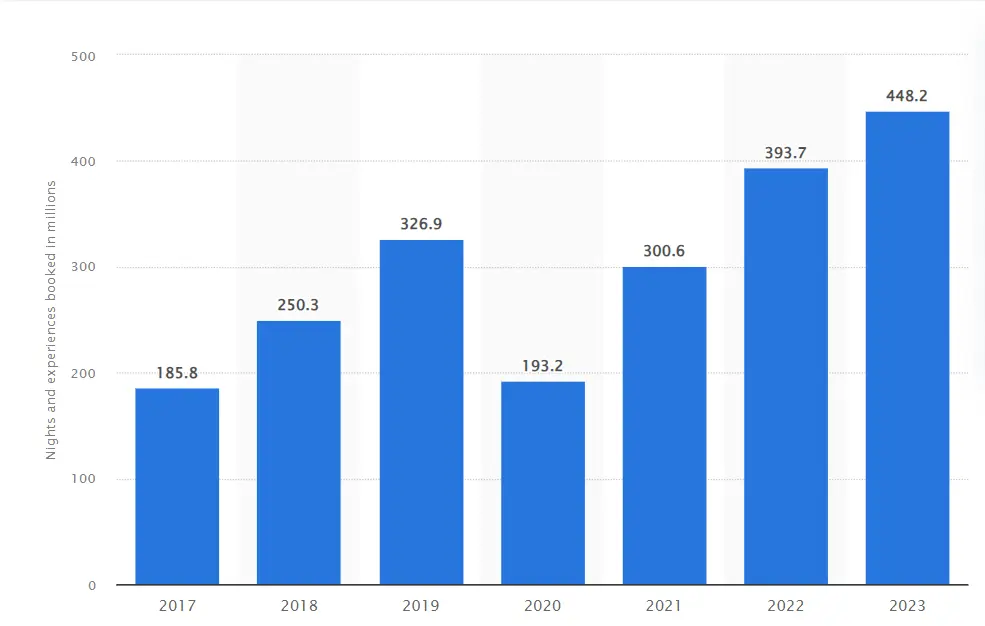

As property managers, staying ahead in this dynamic market means leveraging the right tools to analyze and understand your competition. Here’s a step-by-step guide to analyze your competition, stay ahead, and ensure your competitive pricing strategy is optimized for success.
Step 1: Identifying Airbnb Competition
First, focus on finding listings that closely match your own by considering the following:
- Location: Look for competitors in the same neighborhood or area to make meaningful comparisons. For instance, if you manage a beachfront property in Malibu, identify other beachfront rentals nearby. You won’t get a good analysis if you consider other properties in Las Angeles as your competition since their location attracts different kinds of travelers compared to yours.
- Bedroom and Bathroom Count: Filter for listings with identical bedroom and bathroom configurations. This ensures you’re comparing directly comparable properties. If your property has three bedrooms and two bathrooms, search for other properties with the exact specifications to gauge competition accurately.
- Amenities: Identify listings offering similar amenities, such as pools, parking, or pet-friendly options. If your property boasts a private pool, look for other listings nearby that also feature this amenity. This will help you understand pricing strategies for properties offering similar luxuries as yours.
Step 2: Researching the Competition
Airbnb doesn’t have extensive control over individual listings’ quality or booking activity as a marketplace. So, property managers must ensure that they create high-quality listings and set the right pricing strategy for their hosts. Here are a few things you can do as a property manager if you want to do manual research.
- Identify Successful Listings: Analyze active listings to understand what makes them successful, including pricing, photos, headlines, and descriptions. Review top-performing listings in your area to see how they highlight unique features like ocean views or proximity to local attractions.
- Use Airbnb’s Search Function: Use Airbnb Filters to search for listings by features and amenities to find comparable listings. These filters will help you find listings with specific amenities, such as beach access or gourmet kitchens, similar to those your property offers.
- Map and Neighborhood Filters: Airbnb offers the option to use the map to find listings in a particular neighborhood. You can use this filter to select and identify listings within a half-mile radius of your property to gauge localized competition. You will also be able to see the price of the listings on the map itself.
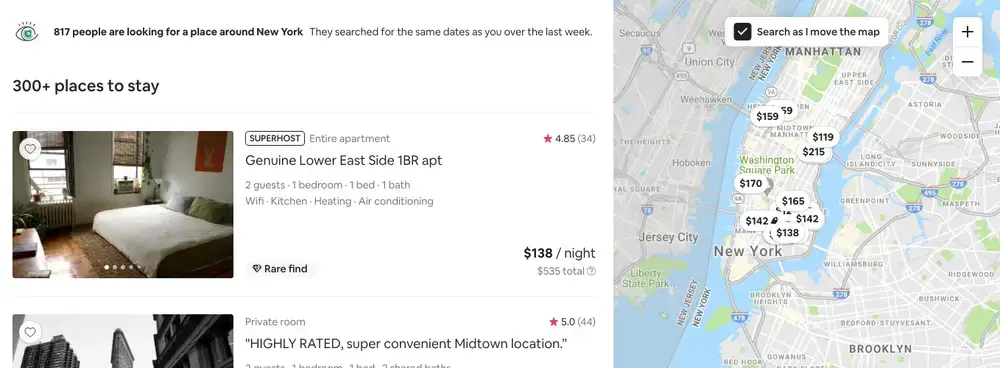

- Refine Your Search: Set specific check-in and check-out dates to accurately compare prices and bookmark filtered search results for future reference. Set dates for peak vacation seasons to see how competitors adjust their rates during high-demand periods.
Bonus Read: Outperform Your Competitors with 30+ Day Strategies with Market Dashboards
Step 3: Using Neighborhood Data For Identifying Airbnb Competition
Manual research is not always a good option for property managers since you have several properties to manage, and it would take up hours of your time to identify Airbnb competition using the practices mentioned above on Airbnb. Instead, you can choose a tool like PriceLabs Neighborhood Data that will aggregate data from nearby listings, allowing you to filter by bedroom count and other criteria to compare your property accurately. Using this tool, you would be able to analyze the following key metrics:


- Pricing: Check average nightly rates using the Future Prices Chart to ensure competitiveness. This chart shows your listing’s last seen price and final prices, along with the 25th-50th, 50th-75th, and 75th-90th percentile daily rates for the following year. Hover your mouse over the chart for detailed price information for specific dates, including the average nightly rates of nearby listings within the selected percentile ranges. You can also track how PriceLabs’ pricing recommendations have evolved. This will offer valuable insights into market trends and help you make informed pricing decisions.
- Occupancy Rates: Assess demand by examining how frequently competitors’ listings are booked. The Future Occupancy Chart visually represents the average occupancy rates in your area over the next year. Hover your mouse over different dates on the chart to see detailed occupancy data for those dates. You can analyze market occupancy to understand seasonal trends in your market and prepare for high and low-demand seasons.


Step 4: Using the Competitor Map
Visualize your competition with the Competitor Map and Competitor Calendar features:
- Competitor Calendar: Using the Competitor Calendar in the Neighborhood Data tab, you can easily compare your listing’s prices, availability, and minimum stay requirements with up to 10 competitor listings. Click on the link to their Airbnb pages to compare amenities and photo quality and identify areas for improvement. Examine pricing, minimum stays, and cancellation policies to understand your competitors’ offerings comprehensively. You can then use that information to enhance your property’s overall appeal and review cancellation policies to align with industry standards.
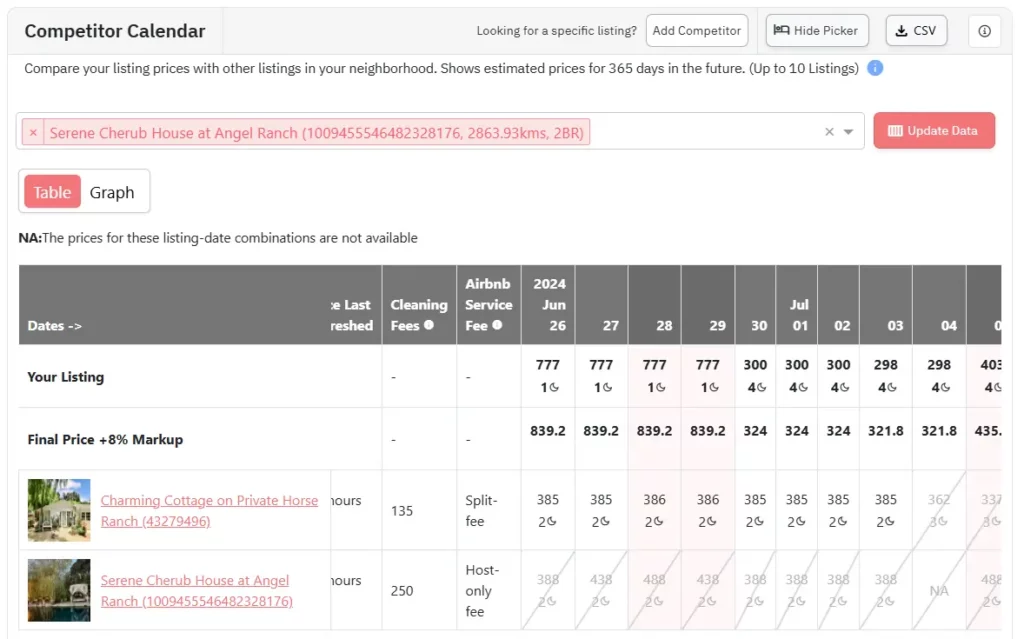

- Competitor Map: You can easily visualize nearby listings and their average daily rates on a map, helping you get a clear picture of the competition’s location and pricing strategies. Click on any listing to see its amenities, design, and overall presentation. This map is a great tool to compare nearby listings’ curb appeal and visual attractiveness with your property.
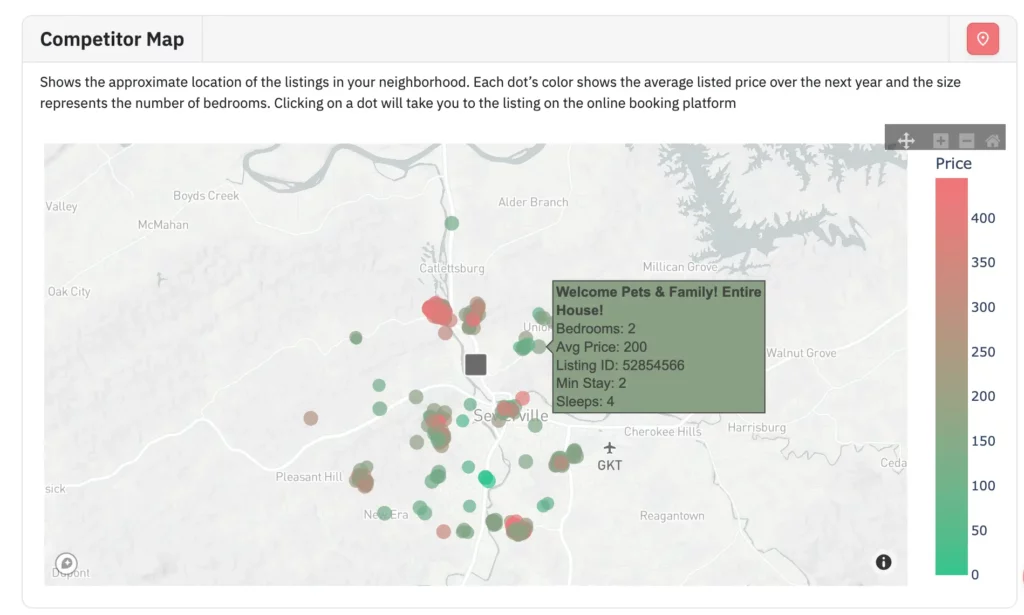

Step 5: Analyzing the Results
Understand your competition’s strengths and weaknesses:
- Identify Gaps: Look for gaps in your offerings compared to your competitors. For example, if nearby properties offer complimentary breakfast options, consider adding this to attract more guests. Similarly, if competitors provide amenities like free parking, bicycles, or local tour guides, these could be areas where you can enhance your listing. Adjust your property to include these features or highlight existing amenities that set you apart.
- Compare Prices: Analyze the average prices and specific details of individual listings in your area. This will help you understand your competition’s pricing. You may notice competitors raising their prices during local events or peak seasons. Adjust your rates to account for vacation rental seasonality accordingly to stay competitive. Similarly, during low-demand seasons, ensure your pricing remains attractive to potential guests by offering discounts or special deals.
- Refine Your Strategy: Make data-driven adjustments to your listing based on your findings. This could include updating property descriptions to highlight recent renovations or new amenities, such as upgraded Wi-Fi, smart home features, or unique local experiences. You can use the Airbnb Description Generator to create high-quality, appealing descriptions and titles for your listing. High-quality photos showcasing these updates can also enhance your property’s appeal. Additionally, consider improving your guest experience by offering personalized touches like welcome baskets or detailed local guides.
Bonus Read: A Complete Vacation Rental Marketing Guide
Step 7: Adjusting Your Listing Accordingly
Once you are done identifying Airbnb competition, it is time to optimize your listing content for better visibility and appeal:
- Use Relevant Keywords: Incorporate keywords related to local attractions and amenities. According to the research published in the International Journal of Hospitality Management, listing descriptions that emphasize unique accommodation aspects and local experiences significantly increase the likelihood of bookings on Airbnb. Specifically, the study found that descriptions highlighting enthusiastic home experiences and unique local guides can attract more guests. Conversely, descriptions that convey hotel-like properties tend to deter potential guests.
- Highlight Local Attractions: Mention nearby points of interest to attract travelers. Highlight access to hiking trails or beachfront access to appeal to adventure seekers and beach lovers.
- Stay Current: Regularly update your listing to reflect seasonal changes and local events. Update listing photos with seasonal décor or promote special events like local festivals or concerts.
Conclusion
Understanding and effectively analyzing your Airbnb competition is crucial for maximizing bookings and revenue in today’s competitive market. Property managers can use tools like PriceLabs’ Neighborhood Data and Airbnb’s search filters to pinpoint local competitors based on location, amenities, and pricing. Insights from research, such as those highlighted in the International Journal of Hospitality Management, emphasize the importance of crafting compelling listing descriptions that highlight unique accommodations and local experiences. Continuously refining your listing strategy based on thorough competitive analysis ensures your property remains attractive and competitive, driving bookings and maximizing profitability on Airbnb.
About PriceLabs
PriceLabs is a revenue management solution for the short-term rental and hospitality industry, founded in 2014 and headquartered in Chicago, IL. Our platform helps individual hosts and hospitality professionals optimize pricing and revenue management, adapting to changing market trends and occupancy levels.
With dynamic pricing, automation rules, and customizations, we manage pricing and minimum-stay restrictions for any portfolio size. Prices are automatically uploaded to preferred channels such as Airbnb, Vrbo, and 100+ property management and channel integrations.
Every day, we price over 350,000+ listings globally across 135+ countries, offering world-class tools like the Base Price Help and Minimum Stay Recommendation Engine. Choose PriceLabs to increase revenue and streamline pricing and revenue management. Sign up for a free trial at pricelabs.co today.


